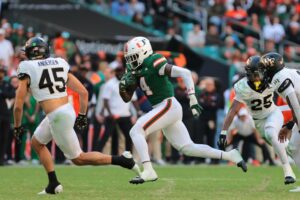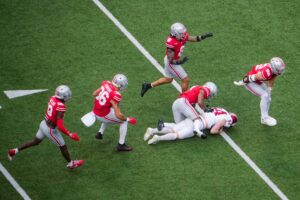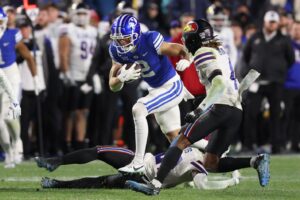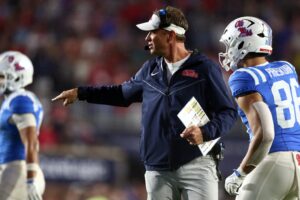As we continue our off-season Summer Simmer series, we turn our attention to the Running Backs. In what is unquestionable the most talented position group returning in the Southeastern Conference, we look at the five best returning SEC running backs for the 2017 season.
Five Best Returning SEC Running Backs
Five is simply not enough for this position group. There are nine returning backs that could legitimately argue that they are in the top five of returning backs this season. And almost all of those could make a strong case for the top spot. For the first time in our series, we’ve even included an honorable mention page because the depth at this position is just that good.
And that’s a good thing, because the quarterback play in the SEC has disappointed in the last few years. 2017 promises more of the same, with a boatload of talent at running back to make up for dearth of top-level talent under center. Here’s our five best returning SEC running backs for 2017.
Previous position groups:
1. Five Best Returning SEC Safeties
2. Five Best Returning SEC Receivers
3. Five Best Returning SEC Cornerbacks
Honorable Mention
This position is so strong, we had to include a whole page for the honorable mentions.
Damarea Crockett, Sophomore, Missouri: Crockett was lost in Mizzou‘s season last year, partly because of how poorly the Tigers played and partly because of freshman quarterback Drew Lock. But Crockett finished in the Top 10 in the conference in yards (9th), average yards per carry (5th), touchdowns (10th), and yards per game (6th). He has excellent explosiveness with 35 runs over ten yards and ridiculous 7.68 yards per carry average on third down. That’s how deep this list is.
Damien Harris, Junior, Alabama: Alabama‘s top back last season waned near the end, but still managed a 1,037 yard season. He’s smaller than his platoon partner, Bo Scarbrough. But size doesn’t matter when you average over seven yards per carry, as Harris did in 2016.
Trayveon Williams, Sophomore, Texas A&M: Another back overshadowed by others on his offense in 2016. All Williams did was carry for 1,057 yards (10th in the league) and 6.78 yards per carry, good for seventh in the league. With the quarterback position up for grabs and the departure of three receivers to the NFL Draft, the diminutive Williams will be in spot light much more in 2017.
Sony Michel, Senior, Georgia: Yes, Nick Chubb gets all the love between the hedges, but Michel is a top-level prospect himself. Sharing the backfield with Chubb hurts Michel’s numbers, but he’s OK with that. He’s also a better option in the passing game. Michel added 22 receptions to go along with his 895 yards last season. With Chubb and some young talent, Georgia has the best backfield in the nation heading into 2017.
Benny Snell, Jr., Sophomore, Kentucky: Snell picked up the slack from Boom Williams in 2016 and ran with the opportunity. Ran with the opportunity to the tune of 1,091 yards (8th) and 13 touchdowns (third best in the league). Snell was a one wrecking crew for the big blue, and his work load needs to come down this year or he could wear down quickly.
That’s just the honorable mention list.
Bo Scarbrough, Junior, Alabama
Scarbrough cracks the top five list on his potential alone. He battled inconsistency and injury in 2016, but finished the campaign strong. In the final three games of the season — the SEC Championship Game, the CFP Semifinal, and the CFP Championship Game — Scarbrough had six touchdowns, 364 yards (121/game), and averaged 7.91 yards per carry.
Scarbrough has ridiculous potential. At 6’2″, 230, he is the mold for the running back position at Alabama. He reminds viewers of Eddie George, with a little more athleticism. While his 2016 campaign was a little disappointing, he did finish eighth among SEC running backs with 11 touchdowns. With Jalen Hurts hopefully one year better and an offensive line returning three starters, this could be the year that Bo Scarbrough finally breaks out.
Combined with Damien Harris, this is one of the best backfields in the nation coming into 2017.
Ralph Webb, Senior, Vanderbilt
No running back in the SEC means more to their team than Ralph Webb. Vanderbilt‘s offense was down right horrible at times last season. But Webb’s workman-like production salvaged a bowl season for the Commodores. Even with defenses keying on him on almost every play, the undersized Webb (5’10”, 202) finished fourth in the conference in yards (1,283), third in touchdowns (13), and fifth in yards per game (98.69).
How important is Webb? He led the league in rushing attempts in 2016 with 250. That’s almost 20 attempts per game. He also had 21 receptions last season. Over the past three seasons he has 3,342 yards and 739 attempts in 37 games on West End. That’s incredible. The only thing more incredible than his numbers is his durability.
The one knock on Webb is stamina. His average was much better on first and second downs than third downs and higher in the third quarter than the fourth quarters. His average on 3rd downs with less than three yards to go was a paltry 1.3 yards. But that’s probably because every single person in the stadium knew who was getting the ball. It might also have to do with those 20 carries a game.
If Vanderbilt could find just a small bit of consistency in the passing game, as they did late in the season against Ole Miss and Tennessee, Webb could really see some big numbers.
Kamryn Pettway, Junior, Auburn
If you took a poll of SEC Safeties and asked them who they least liked to meet in the running lane, it would assuredly be a run-away win for Kamryn Pettway. The 6’0″, 240 pound Pettway is a nightmare for defenders because of his size and his sneaky athleticism.
Pettway put up some numbers that give him a credible argument to be higher on this list. He led the SEC with 122.4 yards per game, was fifth in total yardage with 1,224 (he only played in 10 games), and was fourth in attempts. The most telling statistic: Pettway averaged 8.5 yards per carry on 3rd and less than 3 yards to go. That’s production for you. And to prove he’s not all muscle, Pettway added 30 carries of ten yards or more in 2016.
His only weakness is his receiving abilities out of the backfield.
With the addition of Jarrett Stidham and three returning lineman on an offense that led the league in rushing offense last season (by a sizable margin), Pettway must be excited about the upcoming season. Don’t be surprised if we are talking about him when award season rolls around December.
Nick Chubb, Senior, Georgia
If you are a fan of old school college football, you have to love Nick Chubb. He’s a Jones-Drew type of back that has battled injury his whole career at Georgia. But he, along with Sony Michel, decided to forego certain NFL Draft selection for their senior seasons at Georgia.
Chubb had a breakout freshman season in 2014 with 1,547 yards and 14 touchdowns. A horrific injury sidelined him midway through his sophomore season. He returned last season for another thousand yard campaign (1,130). He’s the active SEC leader in career yardage and if he can stay healthy, he headlines what is likely the nation’s best backfield in Athens.
Much like Ralph Webb, however, Chubb’s numbers in the first half and on first and second downs are better than in the second half and on third down. Unlike Webb, however, Chubb got better later in the season. Most likely due to the fact that Georgia spelled him with Michel and Holyfield throughout the season. He also had 41 runs of ten yards or more. That’s an excellent number for a guy at 230 pounds.
Georgia fans have to be excited for one more season of Nick Chubb. Is this finally actually Georgia’s year?
Derrius Guice, Junior, LSU
Derrius Guice has it all. Size and toughness. Speed and agility. Guice led the SEC in yards in 2016 with 1,387, average yards per carry with 7.58, was second with 15 touchdowns, and second in average yards per game with 115.58. And he did this while being the back-up to a Heisman Trophy candidate and fourth overall pick in the year’s NFL Draft. Not too shabby.
Oh, and he did so without a credible passing attack to help him out. LSU returns three offensive lineman and should have another stout defense, so Guice should get even more work this season.
Guice’s splits were impressive as well. He had better numbers against SEC opponents than non-conference opponents. He got better as the season went on, with a 157 yards per game average for the month of November. And he had 54 runs resulting in first downs.
If LSU is to return to SEC West contention, they’ll have to do it on Derrius Guice’s back. Or on his legs, more appropriately.
Main Photo:






